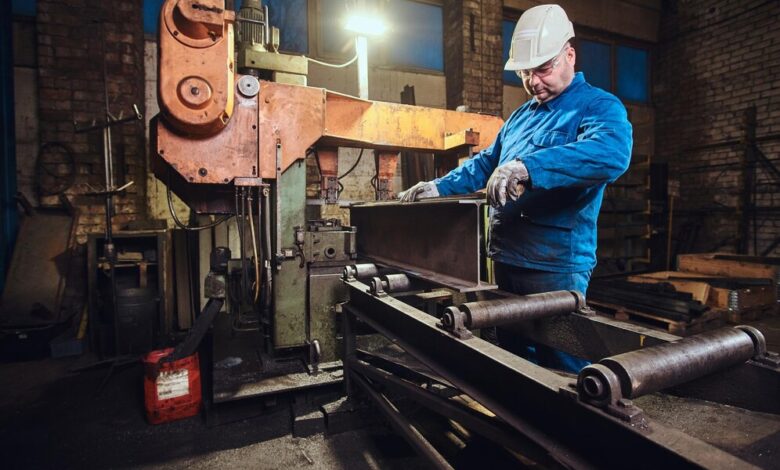The Comprehensive Guide to Metal Sheet Fabrication in India

Introduction
Metal sheet fabrication in India is a very significant segment of the country’s manufacturing industry, whereby flat metal sheets are turned into a wide range of end products through appropriate processes like cutting, bending, welding, and fitting. The industry is servicing mainline sectors like automotive, aerospace, construction, and consumer goods lines with a special focus on technologies including CNC and Laser-cutting for precision and productivity. Is going to grow big on a skilled workforce and significant agility to deal with the future, courtesy of driving demand, government initiatives, and the Make in India campaign.
Metal sheet fabrication dates back to ancient times in India, with artisans creating designs on metals for temples, arms, and household items using only near-primitive tools of that era. Since the 19th century, upon the onset of industrialization, the process has evolved with the help of machinery and modern techniques. As a part of this development in manufacturing post-independence, a large number of units for metal fabrication have been set up countrywide.
Metal Sheet Fabrication Process
Sheet metal fabrication is a large spectrum that deals with the conversion of flat metal sheets into the provided functional products and structures through several stages of precision-driven tasks. The comprehensive process integrates several techniques like cutting, bending, welding, and assembling to derive the end results.
Here are the details for each of the steps in the metal sheet fabrication process:
- Design and Engineering: Starting from design and engineering, detailed blueprints and specifications are made for the fabrication. Independent design engineers or a group of engineers design parts or products using computer-aided design (CAD) software, ensuring they meet a required set of dimensions and specifications. This is very critical because it will help in determining the very best methods to fabricate in terms of materials.
- Material Selection: The selection of appropriate material is quite important to the fabrication process. Common materials include steel, aluminum, copper, and brass, all offering unique properties of strength, malleability, and corrosion resistance. Selection depends on application, environment, and cost considerations.
- Cutting: Once the design and kind of material are agreed upon, the metal sheets are cut to size.
There are several methods of cutting used. Some of them are:
- Shearing: This is done through a blade; straight cuts are made in the metal.
Laser Cutting: A very powerful laser is used to cut with a lot of precision and good details. This is indicated for complex shapes.
Waterjet Cutting: This is where high-pressure water is mixed with some abrasive materials to have the metal cut without its structural integrity being tampered with. - Bending: After cutting, such metal sheets are formed into the shapes desired by the user by applying force in the form of press brakes or any known bending machine. Bending means the application of force to the metal in order to get the desired angle or curve. Bending operations can also be done with CNC machines for higher accuracy and more repeatability.
- Forming: It is the process of shaping the metal using various techniques like rolling, stamping, or punching. Rolling is done to make cylindrical shapes, while stamping and punching are the methods to make holes, depressions, or making specific geometries in the metal sheet.
- Joining and Assembly: Finally, joining, formed parts are welded, riveted, or glued together. Joining is most common with welding – MIG, TIG, spot techniques. Riveting, as well as adhesives, can be used in cases where the parts cannot be riveted together and in situations where there are dissimilar materials that need to be joined.
- Finishing: The final step is finishing, which enhances both the appearance and durability of your fabricated product. The finishing processes are as follows:
Grinding and Polishing: It involves smoothing the surface to remove imperfections and obtaining the desired finish. - Painting and Coating: Involves the application of protective and aesthetic coating systems, such as powder coating, and galvanizing.
Deburring This involves the removal of the metal’s sharp edges and burrs to improve safety and functionality.
Key Players in the Industry
India is amongst those places wherein unfolds a wide and strong fabricating industry for sheet metals, wherein countless companies excel in creating quality sheet metal parts. With several manufacturers, the firm usually supplies to other industries such as the automobile, aerospace, building and construction, electronics, white goods, appliances, etc.
Below are a few major players active in the Indian sheet metal parts manufacturing industry:
Godrej & Boyce Manufacturing Co. Ltd.:
- Overview: Godrej & Boyce is a giant engineering and manufacturing company in India, having a separate division for sheet metal fabrication.
- Specialization: The company deals in full sheet metal fabrication that includes everything starting from cutting, bending, welding, and assembling.
- Catering to Industries: Automotive, aerospace, electronics, and infrastructure.
Larsen & Toubro (L&T):
- Overview: L&T is one of the largest companies dealing in engineering and constructing services, but the services provided in sheet metal fabrication are noteworthy.
- Specialization: Offers advanced solutions for fabrication with world-class facilities and technologies.
- Industries Served: Construction, heavy engineering, power, and defense.
Tata Autocomp Systems Limited:
- Overview: This company is a member company of the Tata Group, which is a big and diversified business powerhouse in the Indian subcontinent and one of the main suppliers of automotive components, including sheet metal items, to the automotive vehicle industry.
- Specialization: High-precision sheet metal components and assemblies that concern the automobile industry.
- Industries Served: Majorly automotive, OEM (Original Equipment Manufacturers) centric.
Hindustan Aeronautics Limited (HAL):
- Overview: HAL is a premier aerospace company in India and has extensive capability for sheet metal fabricating aerospace materials.
- Specialization: High-complexity/high-precision aerospace sheet metal parts.
- Industries where its services are used: Aerospace and Defense.
Jindal Stainless Limited:
- Overview: Jindal Stainless is a leading manufacturer of stainless steel in India and also deals in the fabrication of sheet metal parts.
- Specialization: Provides a wide range of stainless steel sheet metal components with advanced fabrication techniques.
- Industries Served: Construction, automotive, railway, and consumer goods.
Some Successful projects in India
- Mumbai Metro: The actual development of the Mumbai Metro saw elements made of fabricated metal structures used in construction projects such as the stations, the tracks, and other auxiliary structures.
- Automotive Component Manufacturing: OEMs such as Tata Motors and Maruti car manufacturers utilize precision metal fabrications in manufacturing car bodies and parts.
- Wind Turbine Manufacturing: Suzlon Energy, one of the largest wind turbine manufacturers, applies a high level of metals working to establish efficient turbines.
Technological Innovations in Indian Fabrication
The following are ways in which technology has transformed the metal sheet industry through the following integration:
CNC Machining: A CNC system can be integrated into different machining techniques, which today have increased the automation of many fabrication processes. These processes have increased accuracy and.
Robotic welding: the introduction of robots in the welding sector ensures the creation of uniform, top-quality welding, which is vital to most work areas.
Proceedings on IoT and Industry 4.0 technologies support real-time monitoring and optimization of fabrication processes.
Advanced CAD or CAM software helps equally in both the fields of designing and manufacturing for creating workflows.
Government Policies
The Indian government has introduced several policies and initiatives to support the metal fabrication industry:
- Make in India: This lies out of industrialization, which is one of its flagship projects that seeks to encourage manufacturing such as metal fabrication among others through incentives and the development of a suitable business environment.
- Skill India: Stresses vocational education and training, to overcome the shortage of skilled human resources in the market.
- Start-up India: Promotes financial investment and reduces risk for innovators and new business entrants in manufacturing, especially in activities such as metalworking.
- Infrastructure Development Programs: This can be greatly attributed to the government investment in most of the infrastructure projects which in turn creates demand for fabricated metal products.
Conclusion
Sheet Metal Components Manufacturers in India is a vibrant industry that has a rich history and a very promising future. It aids many industries right from constructions to automobiles, and to industries that design end products from industries to consumers. Some of the issues the industry grapples with are the lack of a skilled workforce and infrastructural issues, although the industry harbors many growth opportunities with the ongoing rise in technological improvements and government support. It is a thriving sector, and through innovation, advanced skills, and adopting international quality, the metal sheet fabrication industry in India will continue to blossom and give the country an economic boom.



